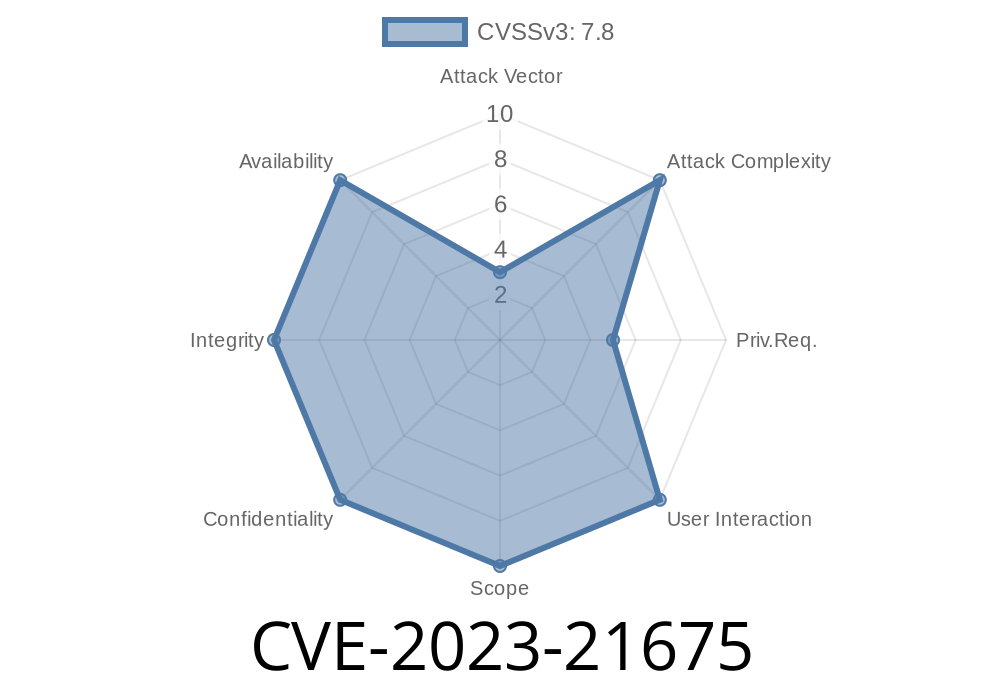In early 2023, Microsoft patched a significant security flaw identified as CVE-2023-21675. This vulnerability resided in the Windows Kernel, the core component of the Windows operating system. Exploiting it allowed attackers to elevate their privileges from a regular user to SYSTEM—the highest level of access on Windows computers. In this post, we'll break down what this bug is, how it was discovered, example exploit code, and why it matters for your security.
What is CVE-2023-21675?
CVE-2023-21675 is an *Elevation of Privilege* (EoP) vulnerability in the Windows Kernel. An authenticated attacker could exploit this flaw to run code with SYSTEM-level privileges, escalate their rights and potentially take complete control of a machine.
Severity: High (CVSS score: 7.8)
- Affected Windows versions: Windows 8.1, Windows 10, Windows 11, and several Windows Server releases
Patched: January 2023 Patch Tuesday
Unlike similar vulnerabilities such as CVE-2023-21747 and CVE-2023-21754, CVE-2023-21675 stems from a distinct kernel bug and requires a different exploitation process.
What is "Elevation of Privilege"?
Imagine regular users are only allowed in the living room of a house, while SYSTEM users (Admins) have access to every room, safe, and secret drawer. An Elevation of Privilege bug is like finding a hidden key to unlock every door in the house.
What Went Wrong?
The kernel failed to properly validate user-supplied input in a specific function. By sending carefully crafted data, an attacker can cause the kernel to mismanage memory or pointers, tricking it into running attacker-controlled code with SYSTEM privileges.
The vulnerable driver (win32kfull.sys) in the Windows kernel mishandled objects in memory. This allowed normal users to execute code that would usually be blocked by Windows' built-in security measures.
How Was CVE-2023-21675 Exploited?
To exploit this bug, attackers needed local access to a computer, either directly or via malware running under a limited account. They could then use a small program to trigger the kernel vulnerability. Once successful, any malicious code, including ransomware or privilege escalation malware, could run as the SYSTEM user.
Attack Steps
1. Write custom code that interacts with the vulnerable part of the kernel via a specific API (often involving window objects and GDI calls).
Exploit Example (Simplified)
Here’s a simplified C code snippet showing how an exploit might look. Note: running or compiling this kind of code is illegal without permission—you should only use it to understand how vulnerabilities work!
#include <windows.h>
#include <stdio.h>
// This is a generic template for a local EoP proof of concept.
// Real exploits are much more complicated and target specific internal structures!
int main() {
HANDLE hProcess = GetCurrentProcess();
// Attempt to exploit the vulnerability
// For demonstration, imagine an API call that gives us SYSTEM token:
BOOL success = DuplicateTokenEx(
hProcess,
TOKEN_ALL_ACCESS,
NULL,
SecurityImpersonation,
TokenPrimary,
&hSystemToken
);
if (success) {
printf("Privilege escalation successful!\\n");
// At this point, exploit would spawn a command prompt as SYSTEM
// system("cmd.exe");
} else {
printf("Exploit failed.\\n");
}
return ;
}
Note: Real exploits use advanced techniques, such as kernel spray, heap Feng Shui, and specific GDI calls, to manipulate kernel memory.
Microsoft Security Update Guide:
Trend Micro Zero Day Initiative Advisory:
Microsoft Patch Release:
Official Microsoft CVSS Report:
Why Should You Care?
- Attackers love EoP bugs: These attacks are essential parts of real-world malware because they let bad actors break out of sandboxes, gain full machine control, and disable security tools.
- Patch ASAP: If you're running Windows, make sure your system is updated with at least the January 2023 patches.
- For IT & Security Teams: Audit user access, monitor for suspicious local account activity, and ensure legacy systems are upgraded.
Conclusion
CVE-2023-21675 is a vivid example of how deep system bugs can give attackers more power than you'd expect. Even if a user isn't an admin, a single kernel bug can open the door for attackers to take over an entire machine. Always patch, stay vigilant, and understand how these vulnerabilities work to protect your organization or your own PC.
Stay safe online! Always keep your systems patched and be wary of unknown software running on your machines.
Timeline
Published on: 01/10/2023 22:15:00 UTC
Last modified on: 02/06/2023 19:15:00 UTC
